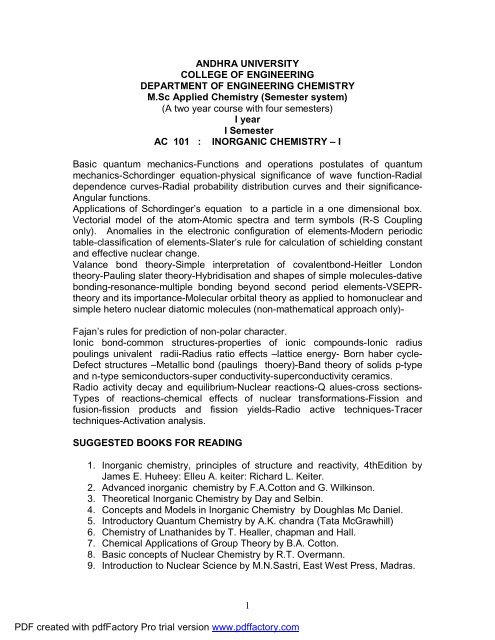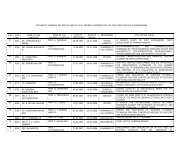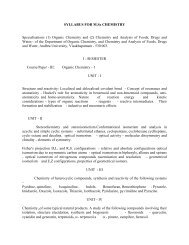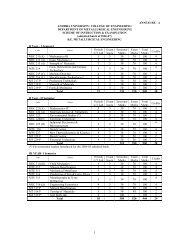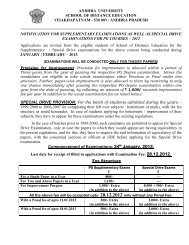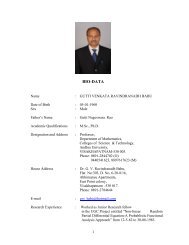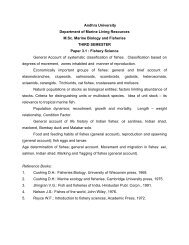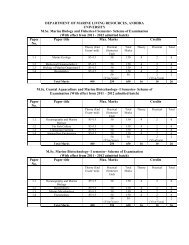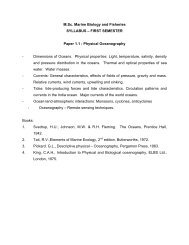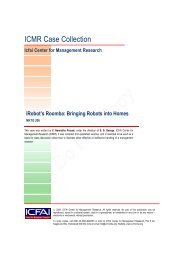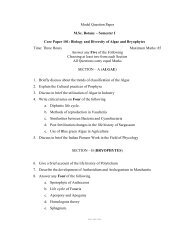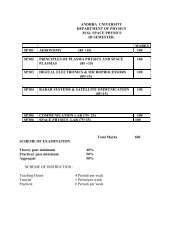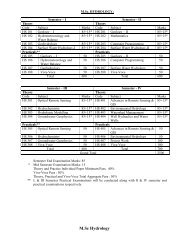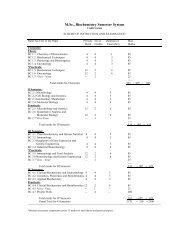M.Sc Syllabus - Andhra University, Visakhapatnam
M.Sc Syllabus - Andhra University, Visakhapatnam
M.Sc Syllabus - Andhra University, Visakhapatnam
Create successful ePaper yourself
Turn your PDF publications into a flip-book with our unique Google optimized e-Paper software.
ANDHRA UNIVERSITY<br />
COLLEGE OF ENGINEERING<br />
DEPARTMENT OF ENGINEERING CHEMISTRY<br />
M.<strong>Sc</strong> Applied Chemistry (Semester system)<br />
(A two year course with four semesters)<br />
I year<br />
I Semester<br />
AC 101 : INORGANIC CHEMISTRY – I<br />
Basic quantum mechanics-Functions and operations postulates of quantum<br />
mechanics-<strong>Sc</strong>hordinger equation-physical significance of wave function-Radial<br />
dependence curves-Radial probability distribution curves and their significance-<br />
Angular functions.<br />
Applications of <strong>Sc</strong>hordinger’s equation to a particle in a one dimensional box.<br />
Vectorial model of the atom-Atomic spectra and term symbols (R-S Coupling<br />
only). Anomalies in the electronic configuration of elements-Modern periodic<br />
table-classification of elements-Slater’s rule for calculation of schielding constant<br />
and effective nuclear change.<br />
Valance bond theory-Simple interpretation of covalentbond-Heitler London<br />
theory-Pauling slater theory-Hybridisation and shapes of simple molecules-dative<br />
bonding-resonance-multiple bonding beyond second period elements-VSEPRtheory<br />
and its importance-Molecular orbital theory as applied to homonuclear and<br />
simple hetero nuclear diatomic molecules (non-mathematical approach only)-<br />
Fajan’s rules for prediction of non-polar character.<br />
Ionic bond-common structures-properties of ionic compounds-Ionic radius<br />
poulings univalent radii-Radius ratio effects –lattice energy- Born haber cycle-<br />
Defect structures –Metallic bond (paulings thoery)-Band theory of solids p-type<br />
and n-type semiconductors-super conductivity-superconductivity ceramics.<br />
Radio activity decay and equilibrium-Nuclear reactions-Q alues-cross sections-<br />
Types of reactions-chemical effects of nuclear transformations-Fission and<br />
fusion-fission products and fission yields-Radio active techniques-Tracer<br />
techniques-Activation analysis.<br />
SUGGESTED BOOKS FOR READING<br />
1. Inorganic chemistry, principles of structure and reactivity, 4thEdition by<br />
James E. Huheey: Elleu A. keiter: Richard L. Keiter.<br />
2. Advanced inorganic chemistry by F.A.Cotton and G. Wilkinson.<br />
3. Theoretical Inorganic Chemistry by Day and Selbin.<br />
4. Concepts and Models in Inorganic Chemistry by Doughlas Mc Daniel.<br />
5. Introductory Quantum Chemistry by A.K. chandra (Tata McGrawhill)<br />
6. Chemistry of Lnathanides by T. Healler, chapman and Hall.<br />
7. Chemical Applications of Group Theory by B.A. Cotton.<br />
8. Basic concepts of Nuclear Chemistry by R.T. Overmann.<br />
9. Introduction to Nuclear <strong>Sc</strong>ience by M.N.Sastri, East West Press, Madras.<br />
PDF created with pdfFactory Pro trial version www.pdffactory.com<br />
1
AC 102 : ORGANIC CHEMISTRY-I<br />
STRUCTURE AND REACTIVITY Properties of organic molecules – concept<br />
of Aromaticity – Types – Huckel and Craig’s rules – Benzenoid and non<br />
benzenoid compounds – annulenes – Hetero annulenes – fullerenes (C 60 )<br />
– Types of organic reactions – mechanisms – Energy and Kinetic aspects –<br />
reactive intermediates – their formation and stability – Aromatic substitution<br />
reactions (electrophilic, nucleophilic and through benzynes) - radical<br />
substitution of arynes . Nucleophilic substitution at a saturated carbon atom –<br />
SN I, SN 2 and SN i reactions. Elimination reactions E1, E2 and E1 c B-<br />
Elimination versus substitution.<br />
REAGENTS IN ORGANIC SYNTHESIS NaBH4, LAH , Lithium disopropyl<br />
amide (LDA)- dicyclohexyl carbodiimide (DCC), 1,3 –Dithiane (reactivity<br />
umpolung), OsO4, SeO2, Crown ethers Wilkinson’s catalyst and 2,3 –<br />
dichloro – 5,6 – dicyano – 1,4,- benzo quinone (DDQ).<br />
STEREOCHEMISTRY Conformanational isomerism – cyclohexanes and<br />
decalins – optical isomerism – optical activity – molecular asymmetry and<br />
dissymmetry. Enantio and diastereo selective synthesis. Chirality – optical<br />
isomerism in biphenyls , allenes and spirans – optical isomerism in Nitrogen<br />
compounds . Geometrical isomerism – acylic and cyclic compounds.<br />
PERICYCLIC REACTIONS Definition – classification selection rules and<br />
stereochemistry of electrocyclic reactions, cycloaddition and sigmatropic<br />
shifts , sommelet – Hauser , cope and claisen rearrangements – Diels – Alder<br />
reaction.<br />
CHEMISTRY OF HETEROCYCLIC COMPOUNDS Synthesis and reactivity<br />
of Benzofuran, Benzothiophene , Indole, Pyrimidine, Pyrazine, Oxazole,<br />
Quinoline and Isoquinoline.<br />
PDF created with pdfFactory Pro trial version www.pdffactory.com<br />
2
AC 103 : PHYSICAL CHEMISTRY –I<br />
SOLID STATE CHEMISTRY – I Introduction, classification, laws of<br />
crystallography, crystallographic systems, space lattice, types of lattices, Brags<br />
Equation, Fourier synthesis, X-ray spectrometer, lane photograph, Rotating<br />
crystal mkethod, Powder method, Neutron Diffraction, Heat capacities of solids,<br />
Molar heat capacities, application, quantum theories of specific heats (Einstein<br />
Equation, Debye equation) Born Hager cycle, cohesive energy Ionic crystal.<br />
Properties of solids, Rhedogical plastic flow and elastic its glass transition<br />
temperature.<br />
SOLID STATE CHEMISTRY – II Defects in solids-point defects- linear defect-<br />
Frenkel & <strong>Sc</strong>hotkey defect (Mathematical derivations). Band theory of solids-<br />
semiconductors – Extrinsic & Intrinsic non stochiometric, organic<br />
semiconductors, p-n junction, rectifiers, transistors, metal purification by zone<br />
refining, preparation of single crystals of Si & Ge (Czochralski crystal pulling<br />
method) doping, Integrated circuits.<br />
CHEMICAL KINETICS –I Introduction, order, molecular its rate constant specific<br />
reaction rate, zero th order first order second order third order rate equations (with<br />
suitable gaseous phase and liquid phase reaction determination of order of<br />
reactions (method of integrations, Time to complete definite fraction of the<br />
reactions, differential method, isolation method) opposing, reactions Hydrogenbromine,<br />
hydrogen- chlorine reactions, consecutive reactions photolysis of<br />
acetaldehyde.<br />
KINETICS – II Theories of reaction rates-(collision and transition state teas).<br />
Fast reaction Flow systems Stoppers flow method Effect of substitute Hemet<br />
equations Taft equation primary and secondary salt effects, effect of dielectric<br />
constant of solvent, ion – ion interaction, catalysis, Acid – base Enzyme<br />
catalysis. Oscillating reactions, Autocatalysis, chemical chaos.<br />
SUGGESTED BOOKS:<br />
1. solid stat3e chemistry by Azaroch.<br />
2. Chemical Kinetics- Laidiler.<br />
PDF created with pdfFactory Pro trial version www.pdffactory.com<br />
3
AC 104 : ANALYTICAL METHODS IN APPLIED CHEMISTRY - I<br />
TREATMENT OF ANALYTICAL DATA Errors in Quantitative Analysis –<br />
Standard deviation-Variance – regression analysis- statistical design of<br />
experiments and sampling . Quality control- standards of purity .<br />
Basic components of computers – comparison of micro, main frame and super<br />
computers. Synopsis of software Packages in Chemistry.<br />
Applications :<br />
1. Standard deviation and variance of universate data.<br />
2. Roots of quadratic – equation and application to hydrogen ion<br />
concentration of strong acid .<br />
3. Rate constant of first order reaction or Beer’s law by least square method<br />
( derivation not needed ).<br />
CONVENTIONAL SEPARATION METHODS Precipitation methods-<br />
Nucleation and crystal growth- purity of precipitate-coprecipitation post<br />
precipitation – homogeneous precipitation ( methods ) techniques and its<br />
advantages. Use of organic reagents as precipitants. Separation by hydroxide<br />
and sulphide precipitation.<br />
MODERN SEPRATION METHODS Solvent extraction- general principles –<br />
classification of extraction systems and applications to chemical analysis.<br />
Chromatography – adsorption – liquid partition – column – TLC- HPLC-GLC –<br />
Basic principles and typical applications to organic and inorganic analysis. Ion-<br />
exchange methods. Cation and anion exchangers – ion exchange<br />
chromatography – Ion exchange separations – molecular sieves.<br />
Zone Refining technique and applications in the purification of semiconductor<br />
materials and preparation of ultrapure compounds.<br />
PDF created with pdfFactory Pro trial version www.pdffactory.com<br />
4
AC 105 : INORGANIC CHEMISTRY PRACTICAL<br />
1. Preparation of vanadium(V) from ammonium metavanadate and<br />
standardisation of vanadium(V) with iron(II)<br />
2. preparation of cerium (IV) sulphate from cerium(IV) oxide and<br />
standardization of cerium (IV) sulphate with iron(II)<br />
3. Estimation of iron(III) by photo chemical reduction method.<br />
4. Analysis of iron(III)-iron(II) present in a synthetic mixture (stannous<br />
chloride method).<br />
5. Estimation of copper(II) present in a brass sample (iodometric method)<br />
6. Determination of chromium(IV)present in a sample of potassium<br />
dichromate.<br />
7. Determination of calcium hardness and magnesium hardness of water<br />
sample.<br />
8. Determination of zinc a ferrocyanide.<br />
9. Determination of chloride in a sample of water(silver nitrate method).<br />
PDF created with pdfFactory Pro trial version www.pdffactory.com<br />
5
AC 106 : PHYSICAL CHEMISTRY PRACTICAL<br />
1. Critical Solution temperature of phenol-water system; effect of Electrolyte.<br />
2. Equilibrium constant of KI +I2-------KI3.<br />
3. Hydrolysis of an ester – A Kinetic study.<br />
4. Dimerisation constant of benzoic acid by the distribution method (Benzene<br />
–water system )<br />
5. Inversion of Surcrose –Akinetic study.<br />
6. Conductometric titration of mixture of weak and strong acid with sodium<br />
hydroxide.<br />
7. Determination of solubility product of a sparingly soluble salt by<br />
conductometric method.<br />
8. Determination of PpKa value of acetic acid using PH Metric method .<br />
9. Formula of Cuprammonium cation –distrubition method.<br />
10. Heat of Neutralisation .<br />
11. Heat of solution.<br />
12. A study of the adsorption of oxalic acid on charcoal.<br />
13. Study of binary liquid mixture involving azeotrope .<br />
14. Study of a two component system involving eutectic or compound<br />
formation .<br />
15. Phase diagram of a three component system ( chloroform –acetic acid –<br />
water )<br />
TEXT BOOKS<br />
1.Practical Physical Chemistry by Alexander .<br />
PDF created with pdfFactory Pro trial version www.pdffactory.com<br />
6
I year<br />
II Semester<br />
AC 201 : INORGANIC CHEMISTRY-II<br />
Co-ordination chemistry of metal complexes valence bond theory of complex<br />
compounds –Inner and outer orbital complexes-Electroneutrality principle and<br />
back bonding –Isomerism in coordination compounds –crystal field theory crystal<br />
field stabilization energy- crystal effects in tetrahedral and square planar<br />
complexes.<br />
Application of crystal field theory to account for spectral and magnetic properties<br />
of complexes and stabilization of an oxidation state of a metal ion in a complex.<br />
Octahedral and planar substitution mechanisms in co-ordination compounds-<br />
Introduction to Molecular orbital theory of complex compounds –Nephelauxetic<br />
effect.<br />
Inorganic reaction mechanisms- concept of hard and soft acids and bases-<br />
Mechanism of redox reactions outer sphere mechanisms ,Inner sphere<br />
mechanisms-Metal cluster compounds-Sandwich compounds and metal<br />
carbonyls.<br />
Chemistry of lanthanides and actinides –Stable oxidation states-Lanthanide and<br />
actinide contraction-Absorption spectra of lanthanides and actinides and their<br />
magnetic properties-separation of Lanthanides and actinides, uses of<br />
lanthanides and their compounds.<br />
Mass bar spectroscopy –principles and chemical applications –counting<br />
techniques-G.M.ionization and scintillation counters-statistics-Application of<br />
Radio-isotopes-Iodine -131 and cobalt-60 in Radio therapy. P32 in fertilizers-use<br />
of r-rays , food preservation,vegetable preservation –leak testing in high vacuum<br />
systems.<br />
PDF created with pdfFactory Pro trial version www.pdffactory.com<br />
7
AC 202 : ORGANIC CHEMISTRY – II<br />
MECHANISMS OF SOME TYPICAL NAME REACTIONS AND PHOTO<br />
CHEMISTRY Aldol , Perkin, Benzoin , Cannizaro ,Wittig, Grignard, Reformatsky<br />
reactions. Favorskii, Wagner-Meerwein, Hofmann, <strong>Sc</strong>hmidt, Lossen,<br />
Curtius,Beckmann, Baeyer-Villiger, Fries rearrangements. Hydroboration,<br />
Oppenauer Oxidation-Clemmenson, Wolf-Kishner,Meerwein-Pondorf-Verley and<br />
Birch reductions-Hofmann-Loffler-Freytag reaction-Michael and Mannich<br />
reactions-pinacol-pinacolone rearrangement.Basic concept of free radical<br />
formation,their stability and polymerisation.<br />
PHOTOCHEMISTRY Jablonski diagram-cis-trans isomerism, paterno-Buchi<br />
reaction, Norrish Type I and II reactions, Barton reaction, di-pimethane<br />
rearrangement.<br />
CHEMISTRY OF NATURAL PRODUCTS Classification,isolation, synthesis and<br />
structural elucidation of terpenoids, alkaloids and purines.<br />
Terpenoids : Camphor, α-Pinene,Santonin, and α and β-<br />
Vetivones.<br />
Alkaloids : Papaverine, Nicotine, Quinine and Atropine.<br />
Purines : Caffeine.<br />
ORGANIC SPECTROSCOPY Basic principles of Absorption spectra –UV –<br />
VISIBLE, IR and NMR spectroscopy methods- Mass spectrometry. Determination<br />
of structure of simple organic compounds like Ethyl alcohol, 1-pentanol, pmethoxy<br />
Benzyl alcohol, P-cresol, phenyl acetic acid, cinnamic acid<br />
pinacolone,Acetophenone, cyclopentanone, salicylaldehyde, Benzyl acetate,<br />
Benzamide, N,N-Dimethyl aniline, 1,3,5- trimethyl benzene.<br />
TEXT BOOKS FOR AC: 102 AND : 202<br />
1. A guide book to mechanisms in Organic chemistry by Peter Sykes :<br />
ELBS.<br />
2. Organic chemistry, Vol. I ( 6 th Edn. ) and Vol. II ( 5 th Edn . ) by I.L. Finar,<br />
ELBS.<br />
3. Organic chemistry by Mukherjee, Singh and Kapoor, Vols. I.and II, Wiley<br />
Eastern<br />
4. Reaction mechanism in Organic chemistry by Mukerjee and Singh,<br />
Macmillan India.<br />
5. Organic spectroscopy by William Kemp, ELBS ( 2 nd Edn .)<br />
REFERENCE BOOKS FOR AC 102 AND AC :201<br />
1.Advanced organic chemistry by Jerry March, Wiley Eastern.<br />
2. Chemistry of Natural Products by K.W. Bentley ( Editor ).<br />
3. Stereochemistry of carbon compounds by E.Eliel, McGraw –Hill.<br />
4.Spectrometric Identification of Organic Compounds by R.M. Silverstein and<br />
Francis X. Webster, 6 th edition, John Wiley and Sons.<br />
PDF created with pdfFactory Pro trial version www.pdffactory.com<br />
8
AC 203 : PHYSICAL CHEMISTRY – II<br />
PHOTO CHEMISTRY Consequences of light absorption – quantum yield and<br />
its determinations – fluorescence , phosphorescence and sensitized fluorescence<br />
– photolysis of aldehydes and ketones photochemical reactions between<br />
hydrogen and halogens – photosynthesis – flash photolysis .<br />
ELECTRO CHEMISTRY Interionic attraction theory of Debye and Huclel –<br />
Onsagor’s modification - determination of activity coefficients from EMF ‘s of<br />
reversible cells – concentration cells with and with out transference, liquid<br />
junction potentials – applicability to hydration numbers – determination of<br />
thermodynamic data from EMF measurements – primary cells fuel cells –<br />
photoelectrochemical cells .<br />
SURFACE CHEMISTRY Adsorption of gages by solids – Langmuir, Freundlich<br />
and B-E-T isotherms – applicability to heterogeneous catalysis – determination<br />
of surface area of adsorbents – Electrokinetic phenomena – Donnan membrane<br />
equilibrium – emulsions .<br />
CATALYSIS Acid – base catalysis , Michaelis – Menten catalysis, chain<br />
reactions- consecutive ,parallel reactions involving unimolecular stops only .<br />
MOLECULAR SPECTROSCOPY Electromagnetic radition – rotation and<br />
vibration of diatomic molecules- selection rules – rotation of polyatomic<br />
molecules – microwave spectroscopy – vibration of polyatomic molecules<br />
infrared and Raman spectroscopy .<br />
SUGGESTED READING FOR AC 103 and AC 203<br />
1. Physical chemistry – S. Glasstone (Macmillan)<br />
2. Physical chemistry – W.J. Moore (Orient Longmans)<br />
3. Physical chemistry – G.M. Barrow ( Mc Graw – Hill )<br />
4. Physical chemistry - S.A. Maron –Prutton ( Collier – Macmillan )<br />
5. Physical chemistry – G.W. Castellan ( Addison – Wesley )<br />
6. Thermodynamics – N.V.Rao ( Macmillan )<br />
7. Molecular Spectroscopy –C.N. B.anwell ( Tata McGraw-Hill )<br />
PDF created with pdfFactory Pro trial version www.pdffactory.com<br />
9
AC 204 : ANALYTICAL METHODS IN APPLIED CHEMISTRY – II<br />
OPTICAL METHODS OF ANALYSIS:SU.V. , Visible, I.R., N.M.R.,and E.S.R.<br />
spectroscopic methods –basic principles, theory, instrumentation and<br />
applications. Flame emmision spectroscopic methods –general principles-<br />
theory – instrumentation and applications.<br />
MODERN METHODS OF CHEMICAL ANALYSIS Electrogravimetry –principles<br />
– theory –instrumentation and applications to chemical analysis.Polarography-<br />
Cyclic Voltametry-principles-theory-instrumentation and applications to chemical<br />
analysis. TGA- DTA and DSC- principles and applications to chemical analysis .<br />
PRESCRIBED BOOKS FOR AC – 104 AND AC 204<br />
1.Quantitative Inorganic Analysis – A.I. Vogel, ELBS. Ed.<br />
2. Instrumental Methods of Analysis – Willard Meritt, J.A. Dean and Settle (6 th<br />
Edn.)<br />
3.Instrumental Methods of Analysis – G.W. Ewing, McGraw- Hill Inc, New York.<br />
4.Instrumental Methods of Analysis – B.K. Sharma, Goel Publishing House,<br />
Meerut.<br />
5.Chemical separation Methods – J. A. Dean, Van Nostrand Reinhold Company.<br />
6.Basics of computers for chemists – P.C.Jurs.<br />
REFERENCE BOOKS<br />
1. Separation methods in chemical analysis by James M. Moller ( Wiely<br />
Interscience 1975)<br />
2. Introduction to separation science By Kargar, Synder and Horwath (willy<br />
Interscience 1975).<br />
PDF created with pdfFactory Pro trial version www.pdffactory.com<br />
10
AC 205 : ORGANIC CHEMISTRY PRACTICAL<br />
Synthesis and purification of about ten organic compounds involving one or two<br />
Stages. Systematic identification of about eight simple organic compounds<br />
having One or two functional groups by functional group analysis, chemical<br />
reaction and Derivatisation<br />
TEXT BOOKS<br />
1 A text book of practial Organic chemistry by A.I. Vogel, ELBS and Longman<br />
group.<br />
2.Practical Organic chemistry by Mann and Saunders, ELBS and Longman<br />
group<br />
PDF created with pdfFactory Pro trial version www.pdffactory.com<br />
11
II Year<br />
III Semester<br />
AC 301 : INDUSTRIES BASED ON ORGANIC RAW METERIALS<br />
CHEMISTRY OF STARCH Structure, Chemical and Physical properties of mono,<br />
di, and polysaccharides. Manufacture and uses of unmodified starch: dextrin<br />
sugar syrup: Hydrolysis of starch to edible and industrial glucose, applications of<br />
starch in textile sizing and in the fermentation industries- Manufacture of<br />
Industrial Alcohol-Manufacture of Vitamin C from glucose.<br />
CHEMISTRY OF CELLULOSE Structure,Chemical and Physical properties.<br />
General reactions ,major sources and uses of cellulose, Enzymatic and chemical<br />
hydrolysis of cellulose- conversion of cellulose to alcohol. Laboratory and<br />
commercial scale preparation of chemical cellulose. Cellulose derivatives like<br />
cellulose nitrate, cellulose acetate.<br />
Different methods of wood pulping: Manufacture and cases of different qualities<br />
of paper products like cardboard, newsprint, writing paper, tissue paper and filter<br />
paper.<br />
PERFUMES Theory of olfaction and mechanism, relation between perfumes and<br />
phermones, classification of perfumes, chemistry, manufacture and isolation of<br />
the following compounds –Citral, Geraniol, Nerol, Linalool, citronellol, hydroxy<br />
citronillol cincal, jasmone, civetone and Muskone, acetylcarane ,acetyl<br />
Longifolene.<br />
PDF created with pdfFactory Pro trial version www.pdffactory.com<br />
12
AC 302 : MINERAL BASED INDUSTRIES<br />
Ferrous and non-ferrous industries-quality-control methods-General principles<br />
applied in studying an industry-Manufacture of iron ,steel and special steels<br />
Metallurgy of gold and silver.<br />
Explosives, classification, characteristics-special explosives- nitrocellulose-T.N.T<br />
Picric acid Dynamite-cordite and Gunpowder.<br />
Classification of cement-Manufacture of portland cement-setting and hardening<br />
of cement. Chemical constitution of Portland cement and their characteristics –<br />
special cements and their uses.<br />
Classification of ceramics –Basic raw metirial- Application of colours to pottery<br />
porcelain and china ware- manufacture. Glass-raw materials, Manufacture of<br />
special glass-optical , Borosilicate, flint and coloured glasses.<br />
Industrial poisons and their classification solid liquid and gaseous poisons-their<br />
identification- physiological activity and control. Solids:Pb, As, Hg, asbestos,<br />
textile fibres. Liquids: organic solvents, gases oxides of S, N and H2S, Cyanides,<br />
Aldehydes, Ketones and Hydrocarbons.<br />
REFFERENCE BOOKS<br />
1. Chemical process industries by N.D. Shreeve.<br />
2. applied chemistry for Engineer by Diamont.<br />
3. Industrial poisons and solvents by Jacobs.<br />
4. chemistry of Engineering materials by Jain & Jain.<br />
5. Engineering chemistry by B.K.Sharma.<br />
6. Environmental chemistry by B.K.Sharma.<br />
7. Corrosion, Volume-I, Metal Environment Reactions by L.L.shreir, Newnes<br />
Butterworths, London.<br />
8. Corrosion Engineering by Fontana and Greene, McGraw Hill Publication.<br />
PDF created with pdfFactory Pro trial version www.pdffactory.com<br />
13
AC 303 : PETROCHEMICALS<br />
PETROLEUM PRODUCTS Origin of petroleum – petroleum resources –<br />
petroleum composition – Nature of crude oil – Different types of crude oil.<br />
General processing of crude oil – Fractionation and stipping . Thermal<br />
decomption process – Stabilization and gas recory. Cracking process – thermal<br />
and catalytic . Blending of gasoline – knocking – Octane number. Aviation<br />
gasoline. Diesel oil – Cetane number Kerosene. LPG – Composition and uses.<br />
Synthetic petrol (Fischer – Tropsch method).<br />
PETROCHEMICCALS Origin of petrochemicals – Types of phemicals. Raw<br />
materials for aliphatic, aromatic and inorganic petrochemicals. Manufacture –<br />
properties and uses of acetone, acetylene, ethylene, propylene, venyl chloride,<br />
butanol, ethyl hexanol and isopropanal.<br />
POLYMERS – I Basic concepts Namenclature- Degree of polymerization –<br />
polymerisition process – Classification of polymerization reactions – Difference<br />
between thermoplastics and thermosets. Types of polymerization – Addition and<br />
step growth. Copolymerisation- Block copolymerisation – Graft copolymerisation.<br />
Stereo isomers – isotactic, atactic and syndyotactic polymers. Mechanism of<br />
polymerization – free radical and ionic. Heterogeneous polymerization – Zeigler-<br />
Natta catalysis. Compounding of plastics – Fabrication techniques of plastic.<br />
PDF created with pdfFactory Pro trial version www.pdffactory.com<br />
14
AC 304 : DRUGS AND DYES<br />
DRUGS – I Introduction - classification – chemotherapeutic agents –<br />
pharmacodynamic agents – Definition of the terms commonly used in the<br />
chemistry of drugs – Definitions of the terms commonly used in the chemistry of<br />
drugs (pharmacy, pharmacology, pharmacodynamics, pharmacopore,<br />
pharmacodynamic agents Metabolites and Antimetabolites, Therapeutic Index)-<br />
Structure & Physiological activity relationship, Assay of drugs (chemical assay).<br />
ANTIBIOTICS Chemical structures , methods of production and medical uses of<br />
pencillin, streptomycin, chloramphenicol, Tetracyclines.<br />
STRUCTURES AND SYNTHESIS OF THE FOLLOWING TYPES OF DRUGS<br />
(Non – structural Streatment only):<br />
SULPHONAMIDES Sulphanilamide, sulphapyridine, sulphathiazole (cibazole),<br />
sulphadiazine, sulphamerazine, sulphaguanidine, sulphisoxazole,<br />
sulphapyrazine, Marfanil (sulphamylon). Mechanism of action of sulpha drugs.<br />
ANTIPROTOZOAL AGENTS Diodoquine Carbarsone<br />
ANTISEPTICS Chloramine- T (chlorozone ), Thymol, Dichloramine- T ,<br />
Iodoform, Dettol, Mandelic acid , Urotropine.<br />
DRUGS – II<br />
STRUCTURE AND SYNTHESIS OF THE FOLLOWING TYPES OF DRUGS<br />
(Non – structural treatment only)<br />
ANTILEPROTIC DRUGS Dapsone (DDS), Acedapsone (DADDS)Chaulmoogra<br />
and Hydrocarpus oil .<br />
ANTI CANCER AGENTS Alkylating agents.<br />
MUSTARDS Melphalan, chlorambucil, Amethopterin.<br />
ANAESTHETICS Benzocaine, pentothal sodium<br />
SEDATIVES , HYPNOTICS and ANTICONVULSANTS (anti epileptics )<br />
Bromural, Barbiturates (veronal ), phenobarbitone, Hydental.<br />
TRANQUILISERS Chloropromazine, Diazepam, Hydroxyzine (atarax ), pipradol<br />
(meratran ).<br />
CARDIOVASCULAR DRUGS Amyl nitrate, Methyldopa.<br />
PDF created with pdfFactory Pro trial version www.pdffactory.com<br />
15
DIURETICS Furosemide (Lasix ) clopamide.<br />
ANTI PYRETICS & ANALGESICS Melubrin, Novalgin, Phenacetin,<br />
Paracetamol, Salicin, Salol, Helicin.<br />
ANTI MALARIALS Chloroquine, Parmaquine, camaquine, Paludrine.<br />
ANTI COAGULANTS Heparin, Warfarin, Dicoumarol, Phenindione<br />
DRUGS USEDD IN DIABETES Tolbutamide.<br />
DYES<br />
Introduction – Dye intermediates - Unit processes in the preparation of dye<br />
intermediates – Structural features of a dye ( Chromophores and Auxochromes )<br />
– Bathochromic and Hypsochromic effects – Diazotization and coupling – colour<br />
and chemical constitution ( Witt’s theory, Armstrong theory &Modern theory) .<br />
Classification of dyes<br />
STRUCTURES AND SYNTHESIS OF THE FOLLOWING TYPES OF DYES<br />
(Non – structural treatment only ):<br />
NITRO DYES Picric acid ,Napthol Yellow S.<br />
NITROSODYES Fast green O, Naphthol green Y.<br />
AZODYES Methyl orange ,Methyl Red, Bismark Brown, Congo Red<br />
PHTHALEINS Phenolphthalein .<br />
XANTHENES Fluorescein .<br />
RHODAMINES Rhodamines B.<br />
HETEROCYCLICDYES Indophenol blue, Phenylene blue . .<br />
THIAZINE DYES Methylene blue .<br />
CYANINE DYES Quinoline blue .<br />
ANTHRAQUINONE DYES Alizarin .<br />
INDIGOIDS Indigo ( Indigotin )<br />
THIOINDIGOS Thio indigo.<br />
PHTHALOCYANINES Copper phthalocyanine.<br />
PDF created with pdfFactory Pro trial version www.pdffactory.com<br />
16
AC 305 : QUANTITATIVE ANALYSIS PRACTICAL<br />
POTENTIOMETRY<br />
1.Estimation of Iron (II) with chromium ( VI ) .<br />
2.Estimation of Iron (II ) with cerium ( IV ) .<br />
3.Estimation Vanadium ( V ) with Iron ( II ) .<br />
PH METRY<br />
4. Titration of a strong acid against a strong base.<br />
5. Titration of a weak acid against a strong base .<br />
6. Titration of a mixture of weak acid and a strong acid against a strong<br />
base.<br />
CONDUCTOMETRY<br />
7. Titration of a weak acid against a strong base.<br />
8. Determination of percentage purity of AgNo3 Solution using KCL .<br />
COLOURIMETRY<br />
9. Estimation of Manganse .<br />
10. Estimation of Fe ( II ) .<br />
VOLUMETRIC ANALYSIS<br />
11. Estimation of ZnSo4 with EDRA .<br />
12. Estimation of Calcium and Magnesium present in a mixture with EDTA.<br />
13. Estimation of Fe ( II ) and Fe ( III ) present in a synthetic mixture .<br />
14. Determination of copper present in a coin or a brass sample.<br />
15. Analysis of Iron ore.<br />
16. Estimation of Manganese in pyrolucite.<br />
17. Determination of D.O. present in a water sample.<br />
Text Books<br />
1. A text book of Practical Inorganic Chemistry by AI Vogel, ELBS<br />
2. Laboratory manual of Engineering Chemistry by Dr Sudha rani<br />
PDF created with pdfFactory Pro trial version www.pdffactory.com<br />
17
II Year<br />
V Semester<br />
AC 401 : OILS, FATS, WAXES, & PROTECTIVE COATINGS<br />
OILS , FATS & WAXES Classification of oils , Vegetable, animal and mineral<br />
oils – Manufacture of Vegetable oils, Chemical properties and uses – Animal fats<br />
and oils, processing, hydrogenation of oils- preparation , properties and uses of<br />
waxes.<br />
SOAPS Manufacture, raw material , typical soaps, Glycerin recovery from soap<br />
manufacture.<br />
DETERGENTS Raw materials – Classification of surfactants- Biodegradability of<br />
Detergents.<br />
SURFACE PROTECTIVE COATINGS Paints – Drying oils , Pigments , Pigment<br />
extenders - Water paints – Special paints – Varnishes , Lacquers and Enamels.<br />
TEXT AND REFERENCE BOOKS FOR AC 301 AND AC 401<br />
1. Organic Chemistry Vol.2 IL Finar 5 th Edn. Longmans 1975<br />
2. Cellulose as chemical and energy resource CH Wilke, Willey-Inter<br />
science, 1975<br />
3. Dryden’s outlines of Chemical Technlolgy 2 nd Edn., edited and revised by<br />
M.Gopala Rao, Marshel sitting – East West Press, 1973.<br />
4. Chemical Process Industries 3 Edn., R Norries Shreve, Mc Graw Hill,<br />
1967.<br />
5. Chemistry of Engg Materials by CV Agarwal.<br />
6. Applied Chemsitry for Engineer’s by Diamont<br />
7. Industrial Chemistry by BK Sharma, Goel Publishing house Meerut.<br />
8. Synthetic Organic Chemistry by OP Agarwal, Goel Publishing house<br />
Meerut.<br />
PDF created with pdfFactory Pro trial version www.pdffactory.com<br />
18
AC 402 : CORROSION AND POLLUTION MANAGEMENT<br />
Basic concepts of corrosion- Dry or chemical corrosion and mechanism pilling<br />
Bedworth rule. Wet or Electrochemical corrosion –Mechanism of wet or<br />
electrochemical corrosion various types of wet or corrosion-Factors<br />
influencing corrosion-some important corrosion control methods –cathodic<br />
protection - Anodic inhibitors - Thermodynamics and kinetics of corrosion<br />
reactions.<br />
Protective coatings Metallic coatings Golvanising and tinning Metal cladding<br />
Electro plating –Metallised coatings chemical conversion or inorganic<br />
coatings- phosphate, chromate, chemical oxide or anodized coatings.<br />
Drinking water or Municipal water treatment purification for domestic use-<br />
Break point chlorination - Desaltination of brackish water : Electro dialysis-<br />
Reverse osmosis- chemical analysis of water (chlorine, acidity, alkalinity,<br />
hardness, D.O only)<br />
Water and soil pollution, water quality standards (India, W.H.O etc) for<br />
drinking water- standards for industrial effluents. Industrial pollutants solids,<br />
liquids and goses and their limitations.<br />
Sources of air pollution extent of air pollution in rural and urban areas<br />
pollution form Metallurgical, Fertilizer and petrochemical industries, sources<br />
of soil pollution types of soil pollution and prevention.<br />
PDF created with pdfFactory Pro trial version www.pdffactory.com<br />
19
AC 403 : POLYMERS<br />
POLYMERS-II Polymer degradation – Types of degradation – thermal,<br />
mechanical, ultrasonic waves, photo-degradation, oxidative degradation (rubber<br />
and phenol-fermaldehyde)and hydrolytic degradation.<br />
Kinetics of polymer reaction – addition – Free-radical , cationic and Anionic<br />
polymerization. Condensation polymerization – acid catalysed condensation<br />
reactions.<br />
Analysis and testing of polymers – weight average nad number average<br />
molecular weights of polymers ratio of Mw and Mn. Determination of molecular<br />
weight of polymers by Cryoscopy – Light scattering – X-ray scattering – Viscosity<br />
– Ultra centrifuge and gel permeation chromatographic methods.<br />
RUBBERS, ELESTOMERS AND ADHESIVES Origion and chemical nature of<br />
natural rubber – D irect processing of lLatex – Compounding of rubber –<br />
Fabrication of rubber – Vulcanization of rubber. Elastomers – Manufacture,<br />
properties and uses of Butadiene, Isoprene and chloroprene. Natural and<br />
synthetic adhesives - Classification animal glue. Protein and starch adhesives –<br />
Resin adhesives. Difference between plastics, elastomers and adhesives.<br />
RECOMMENDED BOOKS FOR AC – 303 & AC – 403.<br />
1. Petroleum products Hand Book, Virgil.B Guthhrie, Editor, 1 st ed Mc Graw<br />
Hill book company Inc 1960<br />
2. chemicals from petroleum , A. L. Waddns and J. Murray, ELBS Edn. 1970<br />
3. Textbook of polymer science P. W. Billmeyer, John Wiley, 1962<br />
4. Introduction to polymer chemistry, Raymond B, Seymour.<br />
5. polymer science, V.R. Gowariker et al ., New A ge I ntl (P)Ltd, New Delhi.<br />
6. organic chemistry of synthetic High Polymers, Robert W. Lenz,<br />
Interscience Publishers.<br />
7. chemical process Industries 5 th Ed , George T. Austin, Mc Graw- Hill<br />
company Inc 1984.<br />
8. Industrial chemistry by B k sherma 5 th Ed 1993.<br />
PDF created with pdfFactory Pro trial version www.pdffactory.com<br />
20
AC 404 : FINE CHEMICALS<br />
FOODS AND FOOD ADDITIVES: Carbohydrates, proteins, water and mineral<br />
substances, Vitamins .<br />
Flavour compounds : Menthol ,pipertone, Vanillin, Eugenol, monosodium<br />
flutamate and carvone.<br />
FLAVOURS: The difference between perfumes and flavours, classification of<br />
flavour compounds , chemistry of species and oleoresins, pepper, ginger,<br />
aniseed, cuminseed, Coriander, Cellery and cardamon, Chemistry of some major<br />
flavours like Coffee , Tea , Cocoa, Onion. Assessment of flavours and blending<br />
of flavours .<br />
SWEETENING AGENTS Saccharine , Sodium Cyclamate.<br />
CHEMISTRY OF AGROCHEMICALS :<br />
INSECTICIDES : DDT, BHC,Aldrin, Endosulfon, Malathion, Parathion.<br />
HERBICIDES : 2,4-dichloro phenoxy acetic acid, dalapon, paraquat, Banalin<br />
Butacarb .<br />
FUNGICIDES : Boardeaux mixture, Copper oxychloride, Zineb,, Benomyl<br />
(Benlate ).<br />
RODENTICIDES: Warfarin, Sodium monofluoroacetate, Zinc phosphide.<br />
PLANT-GROWTH MODIFIERS:Growth Regulators,Second-Growth Inhibitors<br />
andDefoliants,Yield Stimulators<br />
RECOMMENDED TEXT BOOKS : FOR AC 304 AND AC 404<br />
1. Medicinal Chemistry, A. Burger,3 rd Edn ., Wiley, 1970.<br />
2. Chemistry of pesticides, N.M. Melnikov, Residue Reviews, Vol.36,<br />
Springer Verlag, New York , 1971.<br />
3. Future for insecticides , R.C. Netealr, J.J.Mckalvery, Jr. John Wiley<br />
&Sons, New York, 1976.<br />
4. Pesticide processes Encyclopedia, Marshal Sitting Hoyes Data<br />
Corporation, U.S.A.., 1977.<br />
5. Synthetic Organic Chemistry, O.P. Agarwal ,10 th edition , Publishing<br />
House, Meerut, 1994.<br />
REFERENCE BOOKS<br />
1. Burger, medicinal Chemistry, Inter <strong>Sc</strong>ience (1960 )<br />
2. Shreve, Chemical Process Industries, Ch. The Pharmaceutical Industry,<br />
McGraw- Hill (1956).<br />
3. Venkataraman , The Chemistry of Synthetic Dyes, Academic Press.<br />
4. Finar , Organic Chemistry , Vol. I. Ch. 31 Dyes, Longmann.<br />
5. Gilman,Organic Chemistry , An Advanced Treatise Vol. III Ch., 4.Organic<br />
Dyes . Wiley (1953).<br />
6. Juster, Colour and Chemical constitution J. Chem. Educ., 3:596 (1962).<br />
7. Maccoll, Colour and constitution, Reviews (Chem. Soci.) 1:16 (1947 ).<br />
8. Encylopedia of Chemical Technology, Vol 10 and 11.<br />
9. Chemistry of Herbicides, U.S. Sree Ramulu, Oxford & I.B.H. Publishing<br />
Co. ( 1985 ).<br />
PDF created with pdfFactory Pro trial version www.pdffactory.com<br />
21
AC 405 : APPLIED CHEMISTRY PRACTICAL<br />
1. Determination of saponification value of an Oil.<br />
2. Determination of Iodine value of an Oil.<br />
3. Determination of Acid value of an Oil.<br />
4. Estimation of Glucose.<br />
5. Determination of Glucose in Jaggery and Honey.<br />
6. Determination of Molecular Weight of a Polymer.<br />
7. Analysis of Drug.<br />
8. Analysis of Fertilizer.<br />
9. Analysis of Pesticide.<br />
10 .Preparation of Soap.<br />
11.Preparation of cold Cream.<br />
12.Preparation of Shampoo.<br />
13.Preparation of Phenol- Formaldehyde Resin.<br />
14.Preparation of Copper pigment .<br />
15.Preparation of Paracetamol.<br />
16.Preparation of Fluorescein dye.<br />
17.Isolation of Caffeine<br />
18.Isolatiopn of Lycopene<br />
Text Books<br />
And<br />
1. A Text book of practical organic chemistry, A.I. Vogel, ELBS.<br />
2. Laboratory Manual of Organic Chemistry by Raj K Bansal<br />
AC 406 : VIVA- VOCE & RECORDS<br />
AC 407 : PROJECT WORK<br />
PDF created with pdfFactory Pro trial version www.pdffactory.com<br />
22


